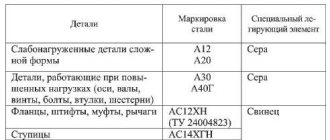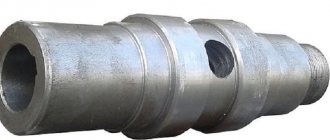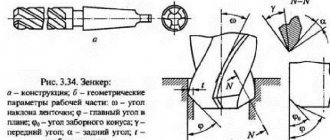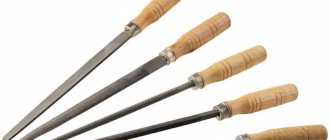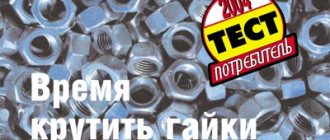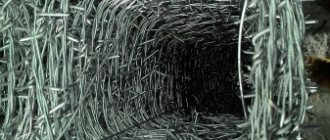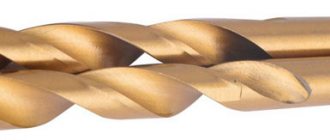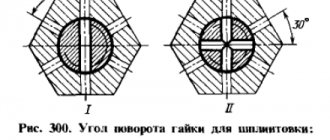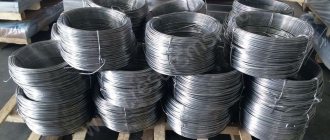Types of countersinks
Countersinks according to their geometric shape are divided into: cylindrical, conical, end-face. Depending on what result should be obtained, the appropriate type of tool is used:
- • for working with cylindrical parts and shapes. They have different diameters and angles of inclination. Designed to expand the hole up to 10 mm. Using a guide pin, recesses for fasteners are made;
- • for working with conical parts (sensors, valves). The surfaces being processed are usually made of cast iron and steel;
- • for processing the end plane of a part or product (booms, bosses).
Countersinks are classified according to the type of construction: solid, prefabricated, welded and with overlay carbide plates. According to the method of fastening: tail and mounted countersinks.
TECHNICAL REQUIREMENTS
1.1. The material and hardness of the main parts of the countersinks must correspond to those indicated in the table. 1.
By agreement with the consumer, it is allowed to manufacture countersinks from alloy steel grade 9ХС in accordance with GOST 5950.
The hardness of countersinks made of 9ХС steel should be HRC3 62…65.
It is allowed to manufacture countersinks and knives for them from other grades of high-speed steel, ensuring the performance and durability of countersinks is not lower than the durability of countersinks made of high-speed steel according to GOST 19265.
(Changed edition, Amendment No. 1, 2).
1.2. Tail countersinks must be welded.
Holes, lack of penetration, burning and burning of metal, ring cracks and fistulas are not allowed at the welding site.
Official publication Reproduction prohibited
★
Standards Publishing House, 1975 IPK Standards Publishing House, 2000 Reissue with Changes
Other methods of connecting the working part of the countersink to the shank are allowed, ensuring the quality of the connection is not lower than welded.
(Changed edition, Amendment No. 1).
1.3. The hardness of the working part of the countersinks must correspond to that indicated in the table. 1 on the length of the helical groove, reduced by a length of no more than 1 x/2 the diameter of the countersink from the weld, but not less than 1 2 3/3 of the length of the helical groove.
The hardness of the shank legs of countersinks with a conical shank should be HRC, 32...47.
(Changed edition, Amendment No. 1, 2).
1.4. The surface roughness parameters of countersinks according to GOST 2789 should not be more than those indicated in the table. 2.
| Table 1 |
| Note. The hardness of the working part of tail countersinks, attachments and knives of prefabricated countersinks made of high-speed steel with a vanadium content of 3% or more and cobalt content of 5% or more should be higher by 1-2 HRC3 units indicated in Table 1. |
GOST 1677-75 S. 3
1.14. Countersinks should have only a uniform reverse taper on the working part (reducing diameter towards the shank).
The reverse taper per 100 mm length must correspond to that indicated in the table. 4.
| table 2 |
| * For ground grooves. ** For milled grooves. |
| Table 4* mm | ||||||||||||||||||
| 1.15. The tolerance for radial runout of the strips along the entire length of the working part of the countersink relative to the axis of the countersink or the axis of the mounting hole, as well as the runout of the main cutting edges when checking at the centers should not exceed the values specified in the table. 5. Table 5
(Changed edition, Amendment No. 1, 3). 1.16. Tolerances of Morse cones are AT8 according to GOST 2848. (Changed edition, Amendment No. 1). 1.17. Maximum deviations of the mounting hole and keyway for mounted countersinks are in accordance with GOST 9472. 1.18. A set of manufactured prefabricated countersinks should consist of an assembled countersink and a set of spare knives. 1.19. The average and established service life of countersinks made of steel grade R6M5 must be no less than those indicated in the table. 5a under the test conditions given in Section. 3.
|
Countersinking
The work is performed on lathes (to produce holes from the end side), drilling, CNC milling and boring machines (to change the size of the hole). The selection of tools is made based on the location of the hole and material, the depth and size of the hole, and the method of fastening. The processing speed in countersinking is identical to the drilling speed. For light steel, the angle of inclination is 15-20 degrees, for medium-light alloys - 8-10 degrees. High-alloy steels and cast iron are processed at an angle of 0-5 degrees, according to GOST 12479-71.
The use of automatic equipment allows us to achieve high precision of the processed surface. When performing work, you must adhere to the following safety rules: the surface of the countersink must be well sharpened and free of burrs and cracks. When attaching the shank, you need to pay attention to the smoothness of the surface as fasteners.
This processing is similar to a drilling operation. Only in the case of countersinking does the final version come out more accurate, the surface cleanliness improves in the process, and any errors are eliminated. Next, reaming is usually performed - a type of finishing.
Countersinking is the secondary processing of ready-made holes for installing bolt heads, rivets, and screws into them.
How to countersink metal correctly
If an amateur craftsman can take a drill and a drill for countersinking, then in an industrial environment the following machines can be used for this:
- drilling;
- turning;
- boring;
- milling;
- aggregate.
The countersinking process takes place in strict accordance with the technology, the general points of which can be described in the form of the following recommendations:
- In cast parts with an uneven margin for subsequent metalworking, it is necessary to bore the hole to a depth of 5–10 mm for the correct direction of movement of the cutting tool.
- For the countersinking operation, an allowance of 1–3 mm is left, depending on the final diameter.
- Countersinking of steel products is not complete without cooling with special oil solutions. When working with cast iron, as well as non-ferrous metal, it is not mandatory.
- The optimal version of the countersink and the operating mode are selected taking into account the required hole diameter, processing accuracy, its depth, the metal of the part and the options of the production machine.
- The cutting tool mount must fit into the slot that is on the workstation.
- In the case where finishing processing by reaming is expected, then during countersinking a part of the allowance, from 0.15 to 0.3 mm, is left for further work.
- To process products made of hardened and alloyed steels, countersinks with carbide inserts with a diameter of 14-50 mm and 3-4 teeth are used.
- When processing non-ferrous metals and iron alloys with a high carbon content, feather countersinks are used.
- High-speed steel tools are used to process products made from ordinary structural steel. For holes larger than 40 mm, the equipment is supplemented with nozzles with a diameter of 32–80 mm.
The discrepancy between the process and the established technology is often the cause of defects. If the tool wears out a lot, the resulting hole will be smaller than the design. When the master has overestimated the feed, or waste has stuck to the teeth of the countersink, the cleanliness of the processing may not satisfy the quality. Other defects: part of the surface is not processed, the resulting diameter is larger than required, are the result of an incorrect choice of countersink or its incorrect installation.
How does a countersink differ from a countersink?
Often a countersink is confused with a countersink. Countersink and countersink - belong to the class of cutting tools, with 3 or more cutting edges. Both tools are used for conical and cylindrical holes. But the countersink expands the hole, at the same time grinding it and adjusting it to the specified parameters. And the countersink only polishes the hole from burrs at the finishing stage.
Operation and repair of metal countersinks
Before you start working, you need to study the safety rules. To protect yourself from injury, you need to:
- Wear a hat, safety glasses, and gloves.
- If work will be carried out on a machine, be sure to install a protective screen made of transparent plastic.
- Wear closed shoes, clothes with tapered sleeves, from which threads and flaps do not stick out.
- Clear the workplace of foreign objects.
- Check the integrity of wires and moving equipment elements.
Do not handle rotating cartridges while wearing gloves.
The countersinking procedure is similar to drilling. After starting the engine, the working part is slowly immersed in a pre-drilled hole. Processing is carried out slowly.
When countersinking, allowances must be observed
It is important to select the diameter of the selected tool so that after processing it coincides with the size of the hole being machined
For repairs and sharpening, it is better to contact a workshop. You won’t be able to fix it yourself; this requires professional equipment and practical skills.
Recommendations for improving the quality of countersinking
In order for the countersinking process to be completed efficiently and quickly, it is recommended to follow some recommendations:
- processing of the hole should be carried out in the same installation of the product in which the drilling itself was carried out - only the type of tool changes;
- when countersinking unprocessed holes of case products, you should carefully monitor the quality of fixation on the working surface of the machine;
- the amount of allowance when working with a countersink is determined according to a special table;
- The drilling and countersinking modes must be the same;
- when working with a countersink, it is recommended to use lubricants;
- It is mandatory to comply with safety regulations, which are also relevant for the drilling process.
Features of working with the tool
If you plan to process a small hole, then countersinking can be done using drilling equipment; When processing holes with large diameters and blind holes, the process should be carried out on stationary equipment, which is installed on a special foundation.
Countersinks are not used for manual processing, since such a process involves achieving maximum precision and smoothness of the surface. The main types of equipment on which the countersink is installed are:
- drilling machines;
- lathes;
- boring machines;
- milling machines;
- aggregate machines.
Areas of application for countersinks
Countersinking and countersinking, despite the fact that they are used for processing pre-prepared holes, have a number of fundamental differences. The main purpose of countersinking is to form conical or cylindrical recesses in the upper part of a pre-prepared hole, which are necessary to hide the heads of the fasteners used.
Conical countersink with Morse shank type 8, cutting part material - HSS steel (analogous to P6M5)
Based on the degree of cleanliness of the recess formed during the countersinking process, such a technological operation is classified as semi-finishing. As a rule, it is performed before drilling holes in workpieces made of various materials. The equipment used for countersinking can be drilling, turning, milling and boring machines. A distinctive feature of this technological operation is that it is performed at low speeds, performed by a countersink or the workpiece being processed.
According to their design, countersinks are distinguished:
- conical (GOST 14953-80);
- cylindrical type.
Types of Conical Countersinks
A separate category of countersinks consists of cutters, which are made of carbide materials and are used primarily for grinding and roughing work. Another type of countersinks that are used for machining and chamfering holes located in hard-to-reach places are reverse-type tools. Specialists who often work with countersinks of this type prefer to have at their disposal entire sets of them, which allow them to process holes with various geometric parameters.
Roller cutter is a type of countersink used for cutting valves of an internal combustion engine
Conical countersinks produced in accordance with GOST 14953-80 have a standard design, the constituent elements of which are a shank and a working part with a front end sharpened to a cone. The cone angle, which is formed by the side surfaces of the front part of such a countersink, can be 60, 75, 90 or 120°. GOST 14953-80 also regulates the number of teeth on the working part, which depends on its diameter.
Thus, countersinks of various diameters (12–60 mm) may contain from six to twelve cutting teeth. Depending on the length of the tool used for processing, which is also regulated by the provisions of the regulatory document, a trunnion can be used to support it on the machine, ensuring the alignment of the surface being formed.
Types of Standard Conical Countersinks
Cylindrical countersinks, in contrast to conical tools (manufactured according to the requirements specified by GOST 14953-80), are specifically used for cutting chamfers for metal products. The working part of such a countersink, which usually has a wear-resistant coating, resembles a drill, but differs from it in a large number of cutting teeth. Depending on the diameter of the working part, it can have from 4 to 10 cutting teeth. To reliably fix the position of such a tool during its operation, there is a special guide pin at its end - solid or removable. The most convenient and practical to use are countersinks with removable trunnions. In addition, for greater efficiency of the processing performed, an additional cutting attachment can be installed on the countersink.
In order to process several holes to the same depth using one countersink, the tool is equipped with a special holder with a limiter, which can be stationary or rotating. In this case, the cutting tool is mounted in a holder, and its working part protrudes from its stop by an amount equal to the depth of the hole being machined.
These chamfers on the holes were made with a conical countersink
Various metals and alloys can be used as materials for the manufacture of countersinks, in particular:
- carbon tool steels;
- alloyed high-speed steel alloys;
- carbide materials.
For processing holes made in soft metals, as well as in materials such as wood or plastic, countersinks made of steel alloys are used. If it is necessary to process holes made in products made of harder metals, then carbide countersinks are used for this. The latter are able to withstand significant loads arising when processing metals with high hardness.
